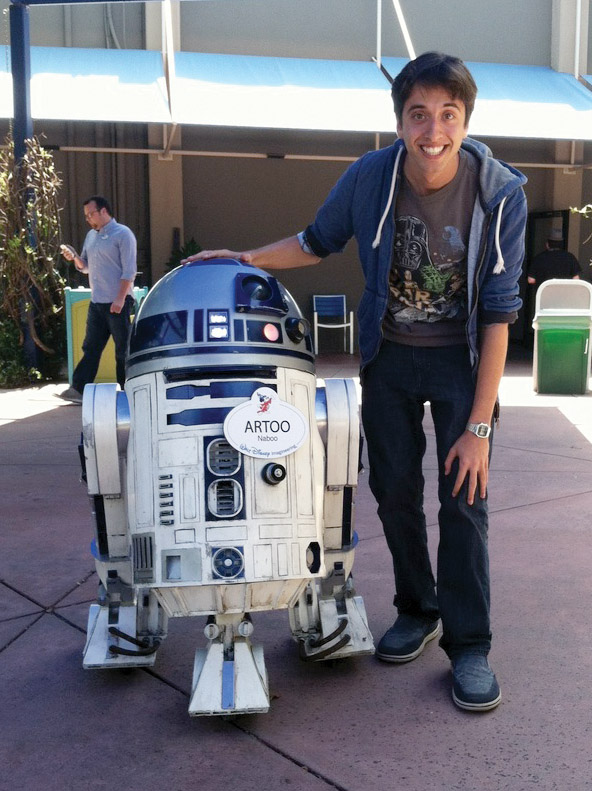Alumnus brings dreams to life with visual artistry at Disney

Andrew Sibner uses skills he learned from his past experience as a psychology student at UCLA in his latest role as an associate visual effects designer at Walt Disney Imagineering.(Courtesy of Andrew Sibner)
By Samantha Suman
Aug. 8, 2016 12:02 a.m.
Braces and a budding geeky personality characterized Andrew Sibner’s early teenage years. Unlike most awkward adolescents, however, he also attended auditions in Los Angeles for movies, commercials and television shows.
The UCLA psychology alumnus of 2014 no longer auditions to be in front of the camera, but is behind the scenes as an associate visual effects designer at Walt Disney Imagineering. He uses his experience in child acting, UCLA clubs and psychology when creating visual media for Disney theme parks, resorts and cruise lines, he said.
“When there is a new attraction at a Disney park, odds are that Imagineering had something to do with it,” Sibner said.
At age 15, Sibner shadowed a family friend who was a visual effects supervisor at Digital Domain. He later participated in a summer internship at the same company, while also cultivating visual effect skills through drawing and teaching himself visual effects software. In the studio, he discovered a way to remain in the entertainment industry without spending time auditioning for shows such as Nickelodeon’s “iCarly” and “Zoey 101.”
“I thought that the people working at the studio were just like me in that they were all kind of geeky and very friendly,” Sibner said. “I felt as though I had found this crowd that I could try to insert myself into one day.”
Sibner said working in visual effects does not necessarily require a degree, however he wanted to go to college to socialize and study a subject he found interesting other than visual effects, which he later found to be psychology.
To maintain and strengthen his skills in visual effects, Sibner joined Delta Kappa Alpha, a cinema fraternity, where he created the visual effects for its films, such as a motion graphic introduction and color corrections. He also joined art club Art Shaped Box on campus to practice figure drawing.
To further refine his visual artistry, Sibner took “Film TV 181A: Introduction to Animation”, with animation professor Chuck Sheetz. Sheetz said Sibner’s acting background helped his animations because he had a better sense of creating a character.
“If you are going to be a character animator, you are an artist, but you are also an actor,” Sheetz said.
While Sibner’s acting experience helps him in producing visual media, he said his studies in psychology help him function well in team-based projects. Sibner said he is very aware of how his actions might be perceived, and believes working well with others is key to progressing in the field of visual effects.
“Good life skills come from being a psych major,” Sibner said.
Tom Gabriel, principal editor for Walt Disney Imagineering, works along side Sibner in the same office. He said Sibner has an excellent work ethic and is visibly happy to be at Walt Disney Imagineering, both of which he said permeate Sibner’s work.
“He is very conscientious of what people are asking for and how to get them what they need and what they want, and does the best job he can,” Gabriel said.
Gabriel and Sibner collaborated to create the visual effects for “Iron Man Experience” at Hong Kong Disneyland. They developed the show’s animatics and 3-D pre-visualization, which Sibner describes as a moving story-board. Sibner said he can’t share too much information about “Iron Man Experience” because it is not yet open to the public.
“We’ve always got to be careful not to spoil the magic,” Sibner said.
Sibner also created the surrounding wall lighting for the live stage show “For the First Time in Forever: A Frozen Sing-Along Celebration” at Disney’s Hollywood Studios in Florida. He said he was responsible for helping make the effects to compliment the show, such as ice effects on the left and right walls when Elsa performs an “ice blast”.
“The lighting will change with each scene and certain effects will happen,” Sibner said.
Another one of Sibner’s bigger projects is “Frozen Ever After” in Epcot at the Walt Disney World Resort in Florida, a ride broken up into “scenes” to mirror that of Disney movies. He worked on color correcting the faces of the characters and helped design the animated effects of a particular “scene.”
Sibner said visual effects is his passion because the format allows him to tell a story that could otherwise not be told. Giving Pixar’s “Finding Nemo” and “Toy Story” as examples, he said these movies would not be possible without the aid of visual effects.
“(Visual effects) let your audience go places they would otherwise never go,” Sibner said.
Sheetz said he is not surprised by Sibner’s success at Walt Disney Imagineering. The professor saw Sibner’s natural grasp for animation in his class and never thought of his major as a roadblock to becoming a professional.
“The (entertainment) business asks a lot of everyone who’s in it,” Sheetz said. “You have to have real love and excitement for what you are doing because that is the only way you are going to get it done. I think Andrew definitely has that.”

